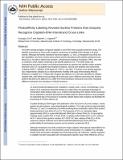| dc.contributor.author | Zhu, Guangyu | |
| dc.contributor.author | Lippard, Stephen J. | |
| dc.date.accessioned | 2013-11-15T18:58:08Z | |
| dc.date.available | 2013-11-15T18:58:08Z | |
| dc.date.issued | 2009-04 | |
| dc.date.submitted | 2009-04 | |
| dc.identifier.issn | 0006-2960 | |
| dc.identifier.issn | 1520-4995 | |
| dc.identifier.uri | http://hdl.handle.net/1721.1/82138 | |
| dc.description.abstract | The DNA-binding inorganic compound cisplatin is one of the most successful anticancer drugs. The detailed mechanism by which cells recognize and process cisplatin−DNA damage is of great interest. Although the family of proteins that bind cisplatin 1,2- and 1,3-intrastrand cross-links has been identified, much less is known about cellular protein interactions with cisplatin interstrand cross-links (ICLs). In order to address this question, a photoreactive analogue of cisplatin, PtBP[subscript 6], was used to construct a DNA duplex containing a site-specific platinum ICL. This DNA probe was characterized and used in photo-cross-linking experiments to separate and identify nuclear proteins that bind to the ICL by peptide mass fingerprint analysis. Several such proteins were discovered, including PARP-1, hMutSβ, DNA ligase III, XRCC1, and PNK. The photo-cross-linking approach was independently validated by an electrophoretic mobility shift assay demonstrating hMutSβ binding to a cisplatin ICL. Proteins that recognize the platinum ICL were also identified in cisplatin-resistant cells, cells halted at various phases of the cell cycle, and in different carcinoma cells. Nuclear proteins that bind to the platinum ICL differ from those binding to intrastrand cross-links, indicating different mechanisms for disruption of cellular functions. | en_US |
| dc.description.sponsorship | National Cancer Institute (U.S.) (Grant CA34992) | en_US |
| dc.language.iso | en_US | |
| dc.publisher | American Chemical Society (ACS) | en_US |
| dc.relation.isversionof | http://dx.doi.org/10.1021/bi900389b | en_US |
| dc.rights | Article is made available in accordance with the publisher's policy and may be subject to US copyright law. Please refer to the publisher's site for terms of use. | en_US |
| dc.source | PMC | en_US |
| dc.title | Photoaffinity Labeling Reveals Nuclear Proteins That Uniquely Recognize Cisplatin−DNA Interstrand Cross-Links | en_US |
| dc.type | Article | en_US |
| dc.identifier.citation | Zhu, Guangyu, and Stephen J. Lippard. “Photoaffinity Labeling Reveals Nuclear Proteins That Uniquely Recognize Cisplatin−DNA Interstrand Cross-Links.” Biochemistry 48, no. 22 (June 9, 2009): 4916-4925. | en_US |
| dc.contributor.department | Massachusetts Institute of Technology. Department of Chemistry | en_US |
| dc.contributor.mitauthor | Zhu, Guangyu | en_US |
| dc.contributor.mitauthor | Lippard, Stephen J. | en_US |
| dc.relation.journal | Biochemistry | en_US |
| dc.eprint.version | Author's final manuscript | en_US |
| dc.type.uri | http://purl.org/eprint/type/JournalArticle | en_US |
| eprint.status | http://purl.org/eprint/status/PeerReviewed | en_US |
| dspace.orderedauthors | Zhu, Guangyu; Lippard, Stephen J. | en_US |
| dc.identifier.orcid | https://orcid.org/0000-0002-2693-4982 | |
| mit.license | PUBLISHER_POLICY | en_US |
| mit.metadata.status | Complete | |
